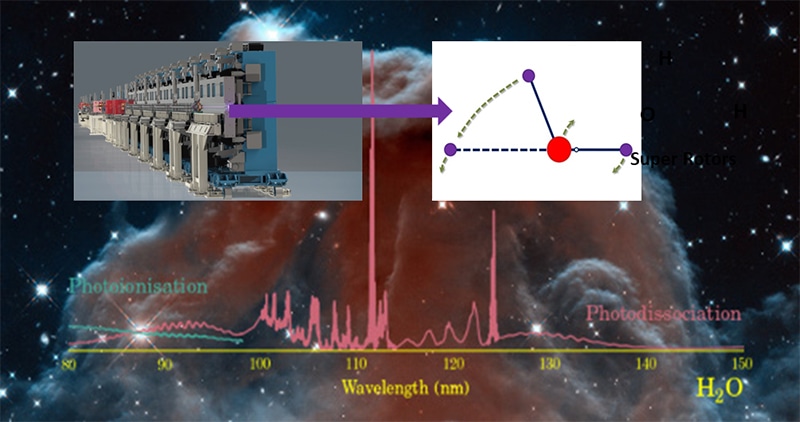Mar 20 2019
Recently, researchers at the Dalian Institute of Chemical Physics of the Chinese Academy of Sciences have shown that hydroxyl super rotors can be produced from water photochemistry with the Dalian coherent light source (DCLS).
 Hydroxyl super rotors produced from water photochemistry by using Dalian Coherent Light Source, the process of which is ubiquitous in the interstellar space. (Image credit: Yuan Kaijun)
Hydroxyl super rotors produced from water photochemistry by using Dalian Coherent Light Source, the process of which is ubiquitous in the interstellar space. (Image credit: Yuan Kaijun)
The scientists, under the guidance of Prof. Yuan Kaijun and Prof. Yang Xueming, have reported their results in Nature Communications.
In interstellar oxygen chemistry, hydroxyl (OH) is the main radical because it has the potential to react with nearly all gases in the interstellar medium. OH radicals have remarkably high rotational levels of excitation and were discovered by astronomers when emitted from HH 211(one of the youngest recognized stellar jets) and the T Tauri star DG Tau.
Although it is most uncertain that such rotationally “hot” OH radicals could be produced from any chemical reactions, it is possible that they can be formed from short-wavelength photolysis of H2O. In this study, through structured studies of vacuum ultraviolet (VUV) water photochemistry, the mechanism of production of rotationally hot OH radicals was determined.
The advent of the intense, pulsed VUV free electron laser at the DCLS opens the way for state-of-the-art molecular photodissociation dynamics studies at any user-selected VUV wavelength. Highly rotationally excited OH radicals, so-called ‘super rotors’ existing above the bond dissociation energy, were observed from the photodissociation of water at 115.2 nm. Such peculiar dissociation dynamics were only observed at around 115.2 nm, which reveals interesting dissociation mechanisms.
Yuan Kaijun, Professor, Dalian Institute of Chemical Physics, Chinese Academy of Sciences
The free electron laser facility paves the way to explore the VUV photochemistry of small molecules. The processes of dissociation of such molecules are very common in interstellar space and have to be identified in suitable interstellar chemistry models.
This study was supported by the Strategic Priority Research Program of the Chinese Academy of Sciences, the Chemical Dynamics Research Center, and the National Natural Science Foundation of China.